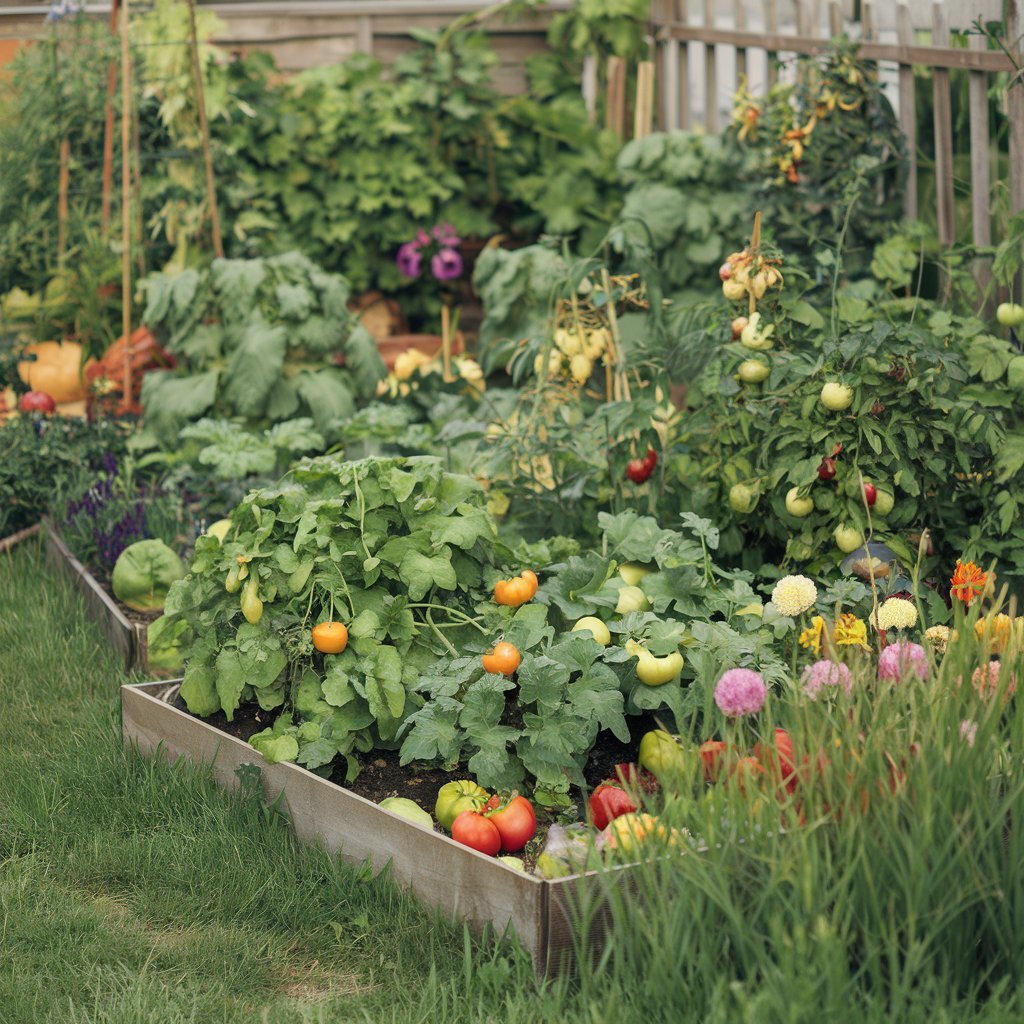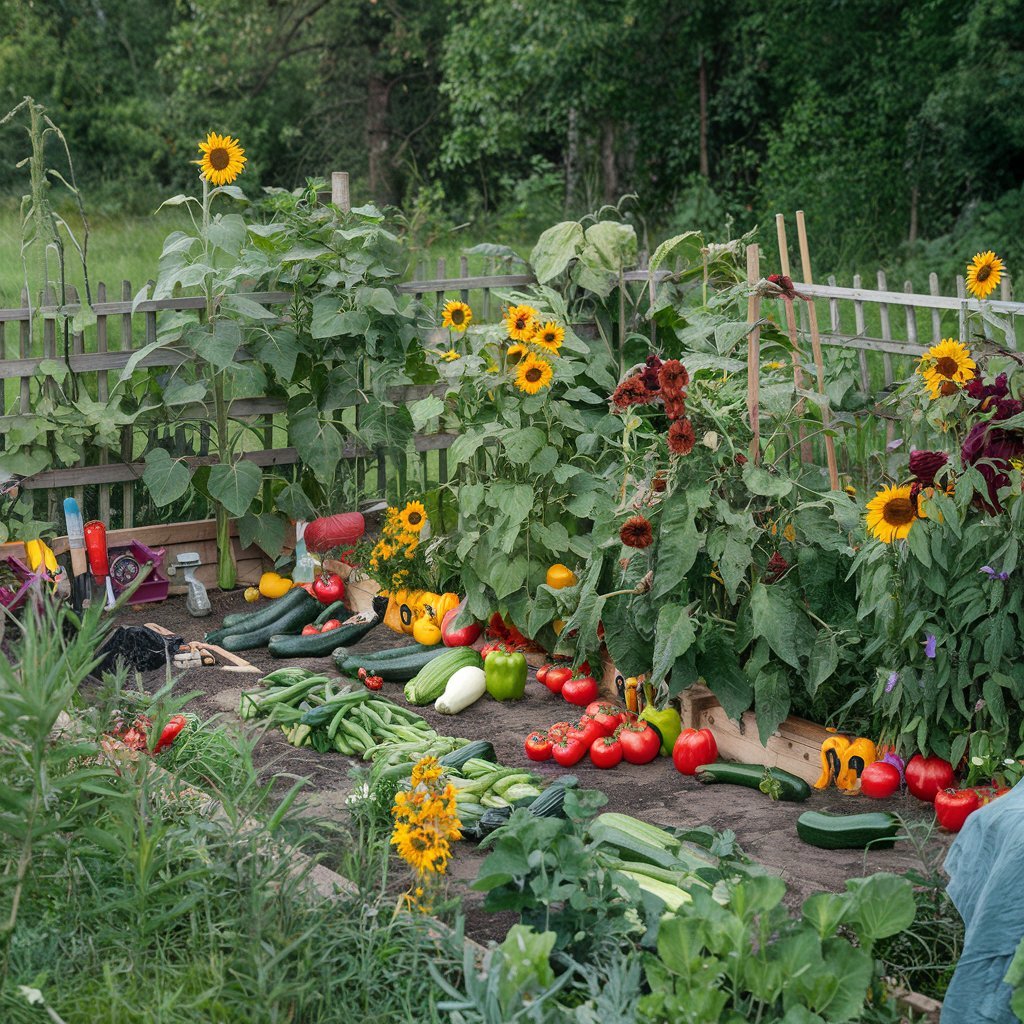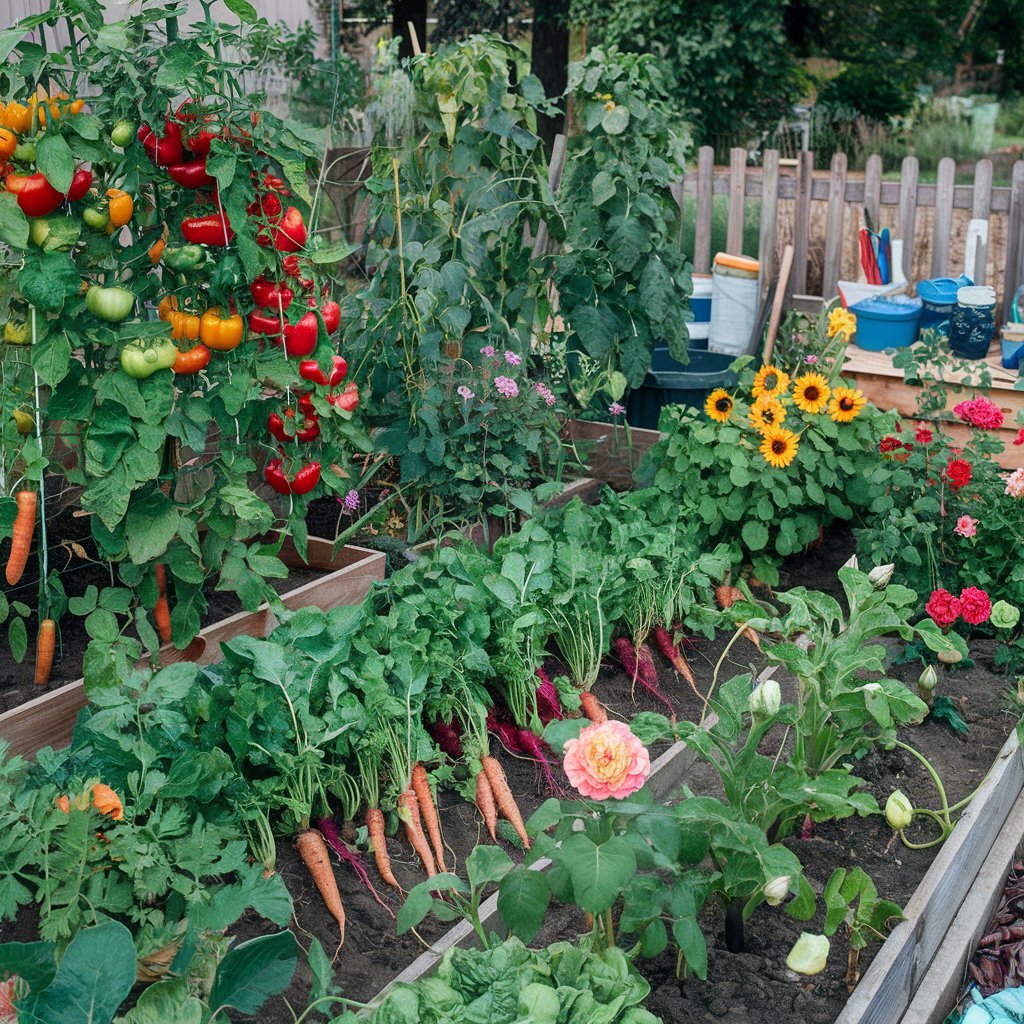The Beauty of Sustainable Garden Design Ideas
Creating a sustainable garden not only helps the planet but also boosts my mood. Sustainable gardening uses eco-friendly techniques to build a better bond with nature.
Why Sustainable Garden Design Rocks
Sustainable garden design uses smart plant choices and materials to make an outdoor space that’s kind to the environment and easy on the wallet. This approach cuts down on upkeep and costs by using natural design principles (Think Architecture).
Here’s why sustainable garden design is da bomb (as the grandkids would say):
- Less Water Needed: By picking drought-resistant plants and using efficient watering systems, I can save a ton of water.
- Stops Soil Erosion: Ground cover plants and mulch keep soil in place, keeping my garden healthy.
- Cheaper to Maintain: Sustainable gardens need less work, saving me time and money.
- Boosts Biodiversity: Using native plants helps local wildlife, like bees and butterflies, thrive.
| Benefit | Why It’s Great |
|---|---|
| Less Water Needed | Drought-resistant plants and smart watering save water. |
| Stops Soil Erosion | Ground cover and mulch keep soil where it belongs. |
| Cheaper to Maintain | Less time and money spent on garden chores. |
| Boosts Biodiversity | Supports local wildlife and pollinators. |
For more tips on sustainable gardening, check out my guide on sustainable gardening practices.
Why Native Plants Are a Game Changer
Native plants are a big deal in sustainable gardening. They’re used to local conditions, so they need way less water than foreign plants (Audubon). This saves time, money, and water.
Here’s why native plants are awesome:
- Easy to Care For: Native plants need less fertilizer and pesticides, making them a breeze to look after.
- Water Savers: They’re used to local rain patterns, so they don’t need much extra watering.
- Healthier Environment: Regular lawns use 10 times more chemical pesticides per acre than farmland. By choosing native plants, I can create a healthier space for my family and community (Audubon).
Using native plants is a smart choice for a thriving, eco-friendly garden. For more tips on using native plants, visit my article on eco-friendly gardening techniques.
By mixing these sustainable garden ideas, I can create a green haven that’s good for my mind and the planet. For more info on sustainable gardening methods, visit my guide on sustainable gardening methods.

Designing a Sustainable Garden
Creating a sustainable garden is a win-win: it’s great for the planet and a boost for your mental health. Two biggies in sustainable garden design are rainwater harvesting and efficient irrigation. Here’s how I tackled these in my own backyard.
Catching That Rain
Rainwater harvesting is a game-changer. By collecting rainwater, I cut down on water bills and help the environment. Here’s what worked for me:
- Rain Barrels: I set these up under my downspouts to catch rainwater from the roof. This stash comes in handy during dry spells.
- Rain Gardens: These are shallow, planted areas that soak up rainwater runoff from roofs and driveways. They look great and do the job.
- Swales: These shallow channels guide rainwater to the thirsty parts of my garden.
Smart Watering
Efficient irrigation is key to saving water. By using systems that cut down on waste, my plants get what they need without overdoing it. Here’s what I found works:
- Drip Irrigation Systems: These deliver water right to the plant roots, cutting down on evaporation and runoff. According to Smart Water Online, drip systems can slash water use by up to 60%.
- Mulching: Putting mulch around plants helps keep the soil moist, stops weeds, and cuts down on evaporation. This simple trick made a big difference in my garden.
- Smart Watering Techniques: I water deeply but not too often, which helps plants grow deeper roots and stay healthy. Watering in the morning reduces evaporation and keeps plants hydrated all day.
| Irrigation Technique | Water Savings (%) |
|---|---|
| Drip Irrigation Systems | Up to 60% |
| Mulching | Improves retention |
| Smart Watering Techniques | Reduces waste |
For more tips on sustainable gardening and eco-friendly techniques, check out our resources. Making these changes in my garden not only made it greener but also gave me peace of mind, knowing I’m doing my bit for the planet.
Building with Sustainable Materials
Creating a sustainable garden isn’t just about planting the right flowers; it’s about picking the right materials too. These choices not only help the planet but also make your garden look and work better. Here’s what I’ve done in my own garden.
Choosing Forest-Friendly Wood
One of my go-to materials is wood from responsibly managed forests. Wood certified by the Forest Stewardship Council (FSC) or the Programme for the Endorsement of Forest Certification (PEFC) is a top pick because it can be carbon neutral (RHS). Using FSC wood means the timber is sourced responsibly, promoting forest conservation and biodiversity.
With FSC wood, I’ve built beautiful raised beds and garden fences. It’s not just about looking good; it’s about supporting sustainable forestry. Plus, wood adds a natural, warm vibe to my garden.
Ditching Concrete for Greener Options
Concrete is everywhere in garden design, but it’s not exactly eco-friendly. Making cement releases almost 1kg of carbon dioxide for every 1kg produced, which is a big deal for anyone thinking green (RHS). So, I’ve looked into better alternatives.
Locally sourced rocks and stones are my favorites. They cut down on transportation energy and blend right in with the natural surroundings (Alchemy Landscape). Reusing materials or finding reclaimed ones also helps the environment and gives my garden a unique touch.
Permeable surfaces like gravel and stone pavers are another great choice. They allow for better drainage, recharge aquifers, and reduce runoff that can pollute water bodies (RHS). This makes for a softer garden that’s kinder to the environment and helps prevent flash flooding.
Check out this table showing the carbon dioxide impact of different materials:
| Material | CO2 Emissions per kg (g) |
|---|---|
| Cement | 1000 |
| Bricks | 250 |
| Stone Patio | 47.5 |
By using these sustainable materials, I’m not just helping the planet; I’m also making my garden look and work better. For more tips on sustainable gardening, check out my articles on sustainable horticulture practices and eco-friendly gardening techniques.
Water-Saving Tips for Your Garden
Want a garden that looks great without guzzling water? Here’s how to make your garden thrive even when water’s in short supply.
Pick Plants That Love the Dry Life
Choosing the right plants can make a huge difference. Go for ones that don’t need much water. Here are some top picks:
- Local Heroes: Plants that naturally grow in your area are used to the local weather. They need less water and help local wildlife.
- Succulents: These plants store water in their leaves. Think aloe vera, agave, and sedum.
- Cacti: These guys are champs at holding water. Perfect for a dry garden.
| Plant Type | Water Needs | Examples |
|---|---|---|
| Local Heroes | Low | Yarrow, Coneflower |
| Succulents | Very Low | Aloe Vera, Sedum |
| Cacti | Very Low | Saguaro, Barrel Cactus |

Want more ideas? Check out our sustainable gardening tips.
Water Smart, Not Hard
Using water wisely can save a ton. Here’s how to do it:
- Deep and Rare: Water your plants deeply but not too often. This helps them grow roots that reach deep into the soil, making them tougher during dry spells.
- Morning Routine: Watering in the morning means less water evaporates. Your plants get a good drink before it gets hot.
- Drip, Drip, Drip: Drip irrigation systems send water right to the roots, cutting down on waste.
| Technique | Benefits |
|---|---|
| Deep and Rare | Strong roots, better drought resistance |
| Morning Routine | Less evaporation, more water for plants |
| Drip Irrigation | Less waste, water goes straight to roots |
Mulching is another great trick. Put mulch around your plants to keep the soil moist, stop weeds, and reduce evaporation (Smart Water Online).
For more eco-friendly gardening tips, visit our eco-friendly gardening section.
By using these water-saving tips, you can have a garden that’s both beautiful and kind to the planet. For more on making your garden sustainable, check out our sustainable gardening guide.
Cool Tech for a Greener Garden
So, you’re diving into sustainable garden design, huh? Well, let me tell you, adding some high-tech gadgets can really boost your garden’s green game. Two nifty innovations to consider are bladeless wind turbines and lithium-glass batteries.
Bladeless Wind Turbines
Bladeless wind turbines are like the silent ninjas of the energy world. Unlike those noisy, traditional wind turbines, these babies, like the ones from Vortex Bladeless, use vibrations from swaying to generate power. Perfect for cramped urban spaces or your backyard (Distrelec KnowHow).
Why should you care? Here’s the lowdown:
- Quiet as a Mouse: No more annoying hums and whirs.
- Low Maintenance: Fewer parts mean less stuff to break.
- Space-Saver: Fits right into small gardens or city spots.
| Feature | Bladeless Wind Turbines | Traditional Wind Turbines |
|---|---|---|
| Noise Level | Low | High |
| Maintenance | Minimal | High |
| Space Requirement | Small | Large |
Adding bladeless wind turbines can work wonders alongside other sustainable gardening hacks in your green space.
Lithium-Glass Batteries
Now, let’s talk batteries. Lithium-glass batteries are the new kids on the block, thanks to John Goodenough. They pack twice the punch of lithium-ion batteries, last longer, and come with a bunch of other perks (Distrelec KnowHow).
Here’s why they rock:
- Energy Powerhouse: Store more juice over time.
- Long-Lasting: Outlive those old lithium-ion ones.
- Cool Operator: Works well even when it’s chilly.
- Quick Charge: Less waiting, more gardening.
- Wallet-Friendly: Cheaper to make.
- Safe and Sound: Non-flammable, so no worries.
| Feature | Lithium-Glass Batteries | Lithium-Ion Batteries |
|---|---|---|
| Energy Density | High | Medium |
| Lifespan | Long | Short |
| Operating Temperature | Low | Medium |
| Charge Time | Quick | Slow |
| Cost | Low | Medium |
| Safety | High | Medium |
Using lithium-glass batteries can supercharge your garden’s energy efficiency while supporting other eco-friendly gardening tips.
These tech wonders not only make your garden greener but also healthier and more vibrant. For more cool tips and tricks, check out our eco-friendly gardening techniques.
Going Green in the Garden
Composting: The Secret Sauce for Soil
One of my favorite ways to keep my garden green and lush is by composting. It’s like turning kitchen scraps and yard waste into black gold. Toss in those grass clippings, fruit peels, and dried leaves, and you get nutrient-packed soil that your plants will love. Plus, it’s a great way to cut down on waste and keep your garden thriving.
When I started composting, I ditched the chemical fertilizers. Compost is a year-round friend, unlike those fertilizers that need a strict schedule. Here’s a quick comparison:
| Aspect | Composting | Chemical Fertilizers |
|---|---|---|
| Application Time | Anytime | Specific Times |
| Environmental Impact | Positive (Recycles waste) | Negative (Chemical runoff) |
| Soil Health | Improves over time | May degrade over time |
I also go old-school with weed control. Hand-pulling weeds or using boiling water works wonders without the nasty chemicals. And to keep pests at bay, I use nets instead of pesticides like Roundup and Paraquat. It’s all about keeping things natural and safe for my garden.
Native Plants: The Local Heroes
Another trick up my sleeve is planting native species. These plants are like the hometown heroes of the garden world. They’re tough, low-maintenance, and perfectly suited to the local climate. This means less work for me and a healthier garden overall.
Native plants come with their own built-in pest and disease resistance, cutting down the need for chemical interventions. Plus, they support local wildlife, creating a mini-ecosystem right in my backyard.
Here’s why native plants rock:
- Less Maintenance: They’re already adapted to the local environment.
- Supports Wildlife: They provide food and shelter for local critters.
- Natural Defenses: They’re tough against local pests and diseases.
For more tips on sustainable gardening, check out our article on eco-friendly gardening techniques.
By composting and choosing native plants, I’ve turned my garden into a sustainable paradise. It’s good for the planet and a joy to tend. For more green-thumb tips, visit sustainable horticulture practices.

My name is Michelle Warren, and I’m the founder of Peaceful Gardening. As a 10-year breast cancer survivor, I’ve discovered the profound therapeutic power of gardening. This journey has not only helped me recover but has also become my passion and a source of ongoing peace and joy.
Peaceful Gardening was born from my desire to share the healing benefits of gardening with others. Whether you’re facing health challenges, dealing with stress, or simply looking to connect more deeply with nature, this space is for you.
Over the past decade, I’ve cultivated not just plants, but a deep understanding of how gardening can positively impact mental health. I’ve worked with local community gardens, led workshops on mindful gardening practices, and collaborated with mental health professionals to develop gardening-based stress reduction programs.
Peaceful Gardening was born from my desire to share the healing benefits of gardening with others. Whether you’re facing health challenges, dealing with stress, or simply looking to connect more deeply with nature, this space is for you.
Here, you’ll find evidence-based advice on using gardening as a tool for mindfulness, stress relief, and emotional healing. I share personal stories, practical tips, and scientifically-backed information on how to create your own therapeutic garden space, no matter the size of your yard or balcony.
My mission is to help you discover the joy, peace, and healing that comes from nurturing plants and connecting with nature. Join me in exploring how the simple act of tending to a garden can transform your mental and emotional wellbeing.
Welcome to Peaceful Gardening – let’s grow together towards better mental health!”

